 |
Using DECwindows Motif for OpenVMS
10.5 Customizing Icons
To customize the appearance and placement of your icons on the
Workspace, choose Icons... from the Workspace Options submenu. The
Window Manager displays the Icon Options dialog box.
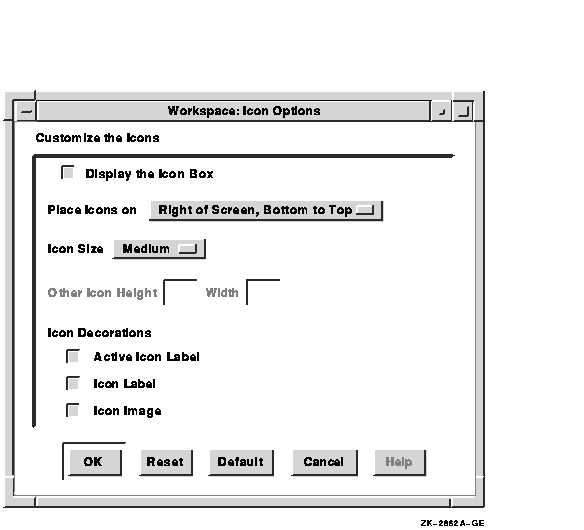
From the Icon Options dialog box, you can change the following settings:
- Display an icon box
- Icon placement
- Icon size
- Icon decorations
10.6 Customizing Icon Colors
To change your icon colors, choose Icon Colors... from the Workspace
Options submenu. The Window Manager displays the Icon Color Options
dialog box.
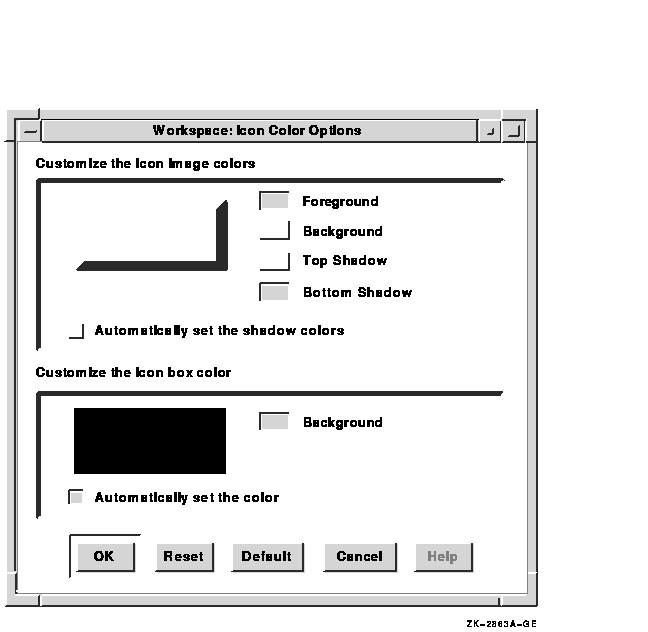
From the Icon Color Options dialog box, you can change the following
icon image and icon box color settings.
| Icon Image Colors |
Icon Box Color |
|
Foreground
|
|
|
Background
|
Background
|
|
Top Shadow
|
|
|
Bottom Shadow
|
|
Foreground
To change the icon foreground color, click on the Foreground button.
DECwindows displays the Color Mixing dialog box, which lets you select
the icon foreground color you want.
Background
To change the icon background color, click on the Background button.
DECwindows displays the Color Mixing dialog box, which lets you select
the icon background color you want.
Top Shadow
Icon top and bottom shadow colors have to be well matched to present
the three-dimensional look of DECwindows Motif. DECwindows helps you to
do this by automatically determining top and bottom shadow border
colors when you change the icon background color. This setting is
indicated by the shaded Automatic shadow check button.
To choose your own icon shadow colors:
- Click on the Automatic shadow check button.
This action
disables the setting.
- Click on the Top Shadow button.
DECwindows displays the Color
Mixing dialog box, which lets you select the top shadow color you want.
You should use the HLS model in the Color Mixing dialog box to choose a
top shadow color that is lighter and less saturated than the background
color.
Bottom Shadow
Icon top and bottom shadow colors have to be well matched to present
the three-dimensional look of DECwindows Motif. DECwindows helps you to
do this by automatically determining top and bottom shadow colors when
you change the icon background color. This setting is indicated by the
shaded Automatic shadow check button.
To select your own Bottom shadow colors:
- Click on the Automatic shadow check button.
This action
disables the setting.
- Click on the Bottom Shadow button.
DECwindows displays the
Color Mixing dialog box, which lets you select the bottom shadow color
you want. You should use the HLS model in the Color Mixing dialog box
to choose a bottom shadow color that is darker and more saturated than
the background color.
Icon Box Colors
To change the icon box background color:
- Click on the Automatic color button.
This action disables the
setting.
- Click on the Background button. DECwindows displays the Color
Mixing dialog box, which lets you select the icon background color you
want.
10.7 Customizing the Matte
To change your matte features, choose Matte... from the Workspace
Options submenu. The Window Manager displays the Matte Options dialog
box.
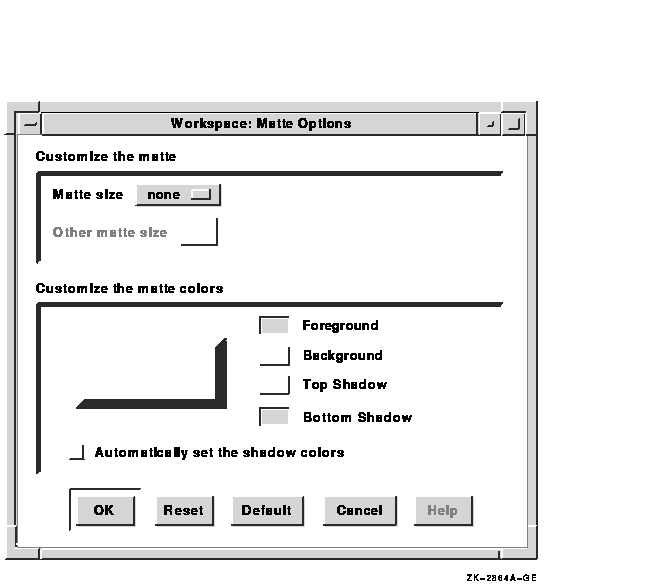
From the Matte Options dialog box, you can change your matte size and
color settings.
10.8 Running the XUI Window Manager
To use the XUI Window Manager instead of the Motif Window Manager:
- Choose Automatic Startup... from Session Manager's Options menu.
Session Manager displays the Automatic Startup dialog box.
- Select XUI Window Manager from the left-hand list box.
The XUI
Window Manager item will be displayed in the right-hand list box.
- Click on the up arrow button to move the XUI Window Manager item to
the top of your Automatic Startup list.
- Select Window Manager from the right-hand list box.
- Click on the left arrow button to remove the Motif Window Manager
from your Automatic Startup list.
- Click on OK.
- Choose Save Session Manager from Session Manager's Options menu.
- Choose End Session from Session Manager's Session menu and end your
session.
- When you start a new session, DECwindows will use the XUI Window
manager.
For more information about adding and removing items from your
automatic startup list, see Chapter 7.
10.9 Advanced Customization
In addition to the menu items available from the Customize submenu, you
can change the appearance and behavior of windows by specifying values
for elements, known as resources in resource
configuration files. The Window Manager gets information from these
files each time you start a session, an application, or the Window
Manager.
For information about modifying resource files, see Appendix E and
the OSF/Motif Programmer's Guide.
Part III
Advanced User Techniques
Part 3 describes advanced techniques for experienced DECwindows
users and system managers. It includes the following chapters:
- Chapter 11 explains how to use hyperapplications to link
information and to follow links.
- Chapter 12 describes how to run applications on remote processors
for display on your workstation, and how to run applications on your
workstation for display on other workstations.
- Chapter 13 explains the DECwindows startup environment and
includes procedures for modifying it.
- Chapter 14 describes how several users can share the same
customized files.
- Chapter 15 lists task messages and describes how to use them in
menu-item command files to make your custom menu items appear better
integrated with Session Manager and FileView. This chapter also
contains a sample command file that shows how these task messages are
used.
Chapter 11
Using Hyperapplications
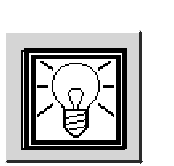
Hyperapplication features allow you to make links between information
that is stored and accessed by DECwindows applications. A
hyperapplication is an application that, in addition
to its regular features (for example, reading online books), allows you
to link information and to follow
links. You can tell that an application is a hyperapplication if it has
the Link menu in its menu bar, as illustrated in the following figure.

This chapter presents a simple example to introduce some basic
hyperapplication concepts and techniques. It discusses linkable objects
(the pieces of information that you can link). It then discusses the
features available from the Link menu, but not in the order that they
appear on the menu. Rather, they are presented in an order to make it
easy for you to learn and use hyperapplication features:
- Creating links (Start Link, Complete Link...)
- Following links (Visit, Go To, Go Back)
- Adjusting highlighting (Turn Highlight On/Off, Highlight...)
- Showing and deleting links (Show Links...)
- Other features (Show History..., Step Forward)
The chapter concludes with a section on advanced LinkWorks concepts.
Note
The LinkWorks Setup application or the LinkWorks Manager application
must have been started before you can use any hyperapplication
features. By default, LinkWorks Setup is automatically started by the
Session Manager when you begin a session.
LinkWorks Manager allows you to perform certain advanced LinkWorks
functions that are not covered in this chapter. See the chapter about
using LinkWorks Manager in the DECwindows Motif for OpenVMS Applications Guide.
|
11.1 A Simple Example
Assume that you use DECwindows Mail to send and receive electronic
messages, and that you use DECwindows Calendar to keep track of your
appointments.
You receive a Mail message notifying you of a meeting two weeks from
now. The message contains a detailed agenda and background information
about the featured speaker. You make an entry for the meeting in a
Calendar timeslot. To identify the timeslot, you simply type in
"Project review meeting" rather than trying to paraphrase the
agenda and speaker information or to cut and paste the complete message
from the Mail window to the timeslot window. However, because you want
to remember later why this meeting is important, you also do the
following:
- With the Mail message selected, pull down the Link menu in Mail and
choose Start Link.
- With the timeslot selected, pull down the Link menu in Calendar and
choose Complete Link.
Later, when you view the entries for the day of the meeting or when you
receive the Calendar alarm --- and you ask yourself, "Why did I
want to go to that meeting?" --- you notice that the timeslot
entry contains a special indicator (a light bulb icon) that tells you
that an information link exists. To see the link, simply do the
following:
- With the timeslot selected, pull down the Link menu in Calendar.
- Choose one of the following:
- Visit --- Displays the information to which this timeslot is linked
but keeps Calendar on the screen.
- Go To --- Shrinks Calendar to an icon and displays the information
to which the timeslot is linked.
In either case, the appropriate application (in this case, Mail) is
automatically invoked and the linked information is displayed. You do
not need to remember that the linked information was a Mail message, or
who sent the message, or when the message was sent, and so on.
11.2 Linkable Objects
Linkable objects are pieces of information in hyperapplications that
you can link together.
Information from any hyperapplication can be linked to information from
the same hyperapplication or from any other hyperapplication. For
example, a Calendar timeslot for a seminar could be linked to a
Bookreader topic for a chapter that covers material to be discussed at
the seminar. You can also link the Bookreader topic to a related topic
in the same manual or in a different manual.
The linking possibilities are rich, and you can make them as complex as
you want: for example, links between a Calendar timeslot and Bookreader
topics and Cardfiler cards, with the topics and cards being linked to
still other pieces of information. You can allow others to see and
follow your links, and you can see and follow links made by others.
We'll see later how you can progress from the simple uses of
hyperapplication features to more complex and powerful uses.
Each hyperapplication determines which of its objects are linkable
objects, based on the importance and granularity of objects. For
example, a Cardfiler card is a linkable object, but a part of a word
within a card is not. For a listing of the linkable objects for a
specific hyperapplication, see its documentation in the DECwindows Motif for OpenVMS Applications Guide.
To use the features described in the chapter, you should be familiar
with one or more hyperapplications and know how to select objects using
those applications. (As a general rule, clicking on an object selects
it; however, the method of selection can vary depending on the
application and the object. For example, some objects are selected by
clicking and dragging.)
11.3 The Link Menu
The presence of the Link menu (see the following figure) indicates that
an application is a hyperapplication. You use the Link menu to take
advantage of the hyperapplication features described in this chapter.
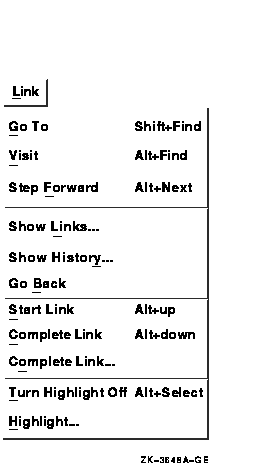
11.4 Creating Links
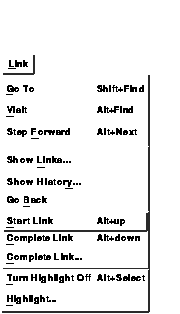
Each link involves two hyperapplication objects. One of these objects
becomes the source for the link, and the other becomes
the target.
Do not become confused by these terms, because for any given link it
does not matter which object is the source and which is the target ---
unless you choose to make it matter. You can selectively enable and
disable highlighting (discussed later) for sources and targets, and
some displays of link information use these two terms. However, when
you select an object and retrieve the information to which it is
linked, it does not matter whether the object you select was designated
as a source or a target: the linked information is still retrieved.
For each pair of objects to be linked, the object selected for Start
Link is made the source and the object selected for Complete Link... is
made the target. You might want to make the object you were initially
viewing the source and the other object the target. For example, you
might make the source a Calendar timeslot about a seminar and the
target a Bookreader table of contents entry about the seminar's
subject. However, the choice of source and target designations for each
link is up to you.
To create a link, do the following:
- Select an object.
- Use the Link menu of the hyperapplication for that object
to choose Start Link. The selected object becomes the source when you
complete the link.
- Select the second object.
- Use the Link menu of the hyperapplication for that object to choose
either the Complete Link or Complete Link... item. In either case, the
selected object becomes the target in the link.
- The Complete Link item uses LinkWorks default values to create the
link.
- The Complete Link... item displays the following dialog box.
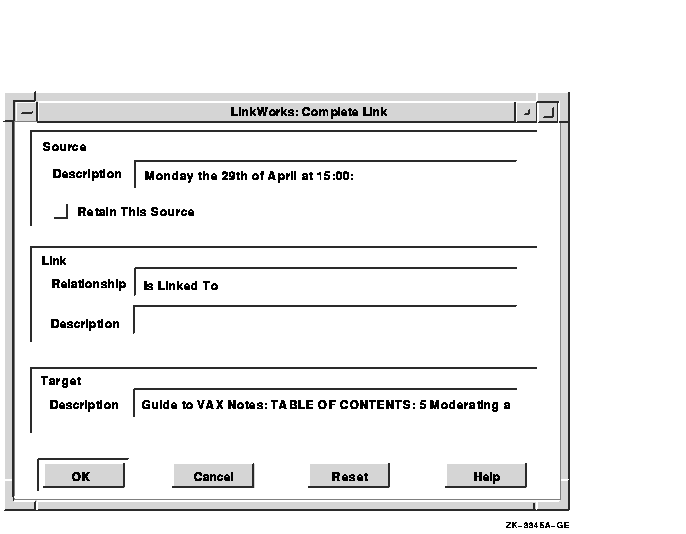
You can edit the descriptions of the source, the target, and their
relationship, and you can enter a word or phrase to describe the
relationship. You can enter any text you like in these entry boxes.
The Retain This Source button allows you to create multiple links
to the same object conveniently. By default (button set off), the
source is no longer considered pending (for use in the next link) after
the link is created; and to create another link you would have to
select two objects, one for the Start Link and one for the Complete
Link... operation. However, if you want to make another link using the
same source, set the Retain This Source button on; then select the
target object for the next link and choose Complete Link... item.
11.5 Following Links
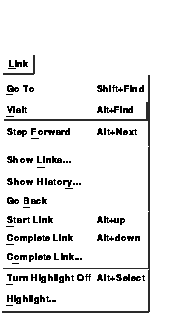
When you have selected one end of a link (the source or the target),
you can follow the link to see the information at the other end.
However, you must first be able to see which objects are linked and
which are not. Objects that are linked are highlighted, unless you
disable highlighting (as explained later in Section 11.6).
The method of highlighting varies depending on the application. To see
how linked objects are highlighted by a specific hyperapplication, see
the DECwindows Motif for OpenVMS Applications Guide.
When you select an object and want to see what it is linked to, you can
choose one of these options:
- Visit
Visit invokes the appropriate hyperapplication and
displays the linked information, but it keeps your current
hyperapplication window open and keeps input focus in this window. This
menu item is useful if you want to continue working with the current
hyperapplication after you finish viewing the linked information.
- Go To
Go To minimizes (shrinks to an icon) your current
hyperapplication window, and then invokes the appropriate
hyperapplication and displays the linked information. This menu item is
useful if you want to shift your work to the invoked hyperapplication
or if you want to reduce clutter on the screen.
To visit or go to the information to which a linkable object is linked,
follow these steps:
- Select a highlighted object.
If you cannot tell which objects
are linked and which are not, enable highlighting (see Section 11.6).
- Choose the Go To or Visit menu item from the Link menu.
If the
selected object is involved (as source or target) in only one link,
then the Visit or Go To operation is performed immediately.
If the
selected object is involved in multiple links, the Links dialog box
appears, presenting you with a list of links from which you can make a
selection.
The following figure illustrates the Links dialog box showing a
Bookreader topic linked to two objects: a Calendar timeslot and a
Cardfiler card.
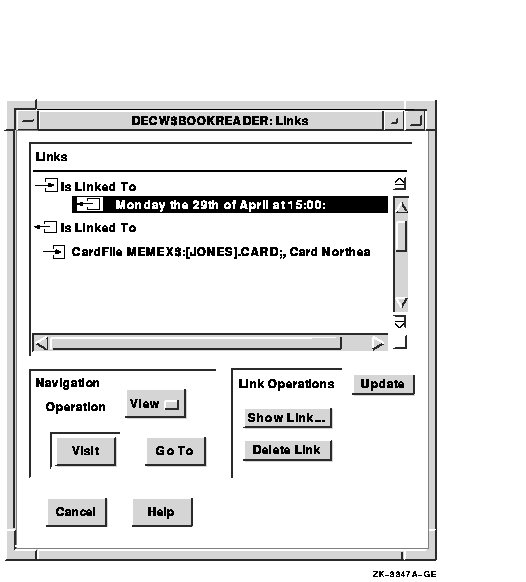
The direction of the arrows indicates whether the object is a
source (right arrow) or a target (left arrow). In the preceding figure,
a chapter in the Guide to VAX Notes is the target in a link to
a Calendar entry for a seminar on advanced Notes topics at Northeastern
University, and the chapter is the source in a link to a card with
directions for driving to the university.
To follow a link, perform these operations using the Links dialog box:
- Select one of the links. The first link in the list is selected by
default.
- Choose an operation. The operation that is visible in the Operation
options menu is selected by default.
- Click on Go To or Visit to follow the selected link to the
destination object and to perform the specified operation.
Click on
Update to update the display of link information. This choice is useful
if you have made or modified any links after you displayed the dialog
box.
Click on Show Link... to display a dialog box with information
about the link. You can edit this information, as explained later in
Section 11.7.
Click on Delete to delete the selected link. This
action does not delete the object; rather, it simply makes the object
no longer the source or target of the link. See Section 11.7 for more
information on deleting links.
Click on Cancel to dismiss the
dialog box without following any link.
Note
Double clicking on a link is the same as choosing the default menu item
(Visit) with the default destination operation on that link. You can
use this shortcut if you want to accept the defaults.
|
To reverse the effect of the most recent Visit or Go To operation, use
the Go Back menu item. Go Back is useful if you "change your
mind" after performing a Visit or Go To operation and want to
return to where you were. The Go Back operation does not delete or
otherwise affect any actual links.
11.6 Adjusting the Highlighting
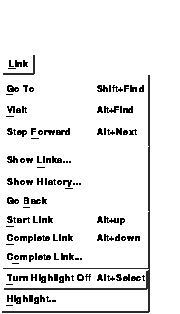
For each hyperapplication, you can enable or disable the highlighting
of linked objects; that is, the fact that these objects are linked can
be made visible or not visible, depending on whether or not you want to
use the features described in this chapter. You can also control which
kinds of linked objects are highlighted when highlighting is enabled.
Use the Turn Highlight On/Off menu item to enable and disable
highlighting. The wording of this item depends on the current state: if
highlighting is enabled (the initial default), this item says Turn
Highlight Off; if highlighting is disabled, this choice says Turn
Highlight On. Disabling highlighting does not disable the use of
hyperapplication features; however, it makes their use impractical
because you are unable to see which objects have links.
The Highlight... menu item allows you to specify the kinds of objects
to be highlighted. This item displays the Highlighting dialog box.
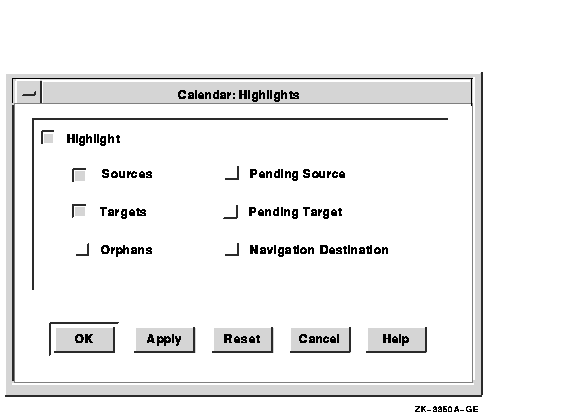
Because this dialog box refers to important concepts, you should
understand them before you try to set the buttons:
- Source or target
One end of a link between two objects. You can
make either end of a link the source and the other end the target,
depending on your personal preferences or conventions.
The object
selected for the Start Link item becomes the source. The object
selected for the Complete Link or Complete Link... item becomes the
target.
- Orphan
An object that either (1) was linked to another object
but is not linked to that object anymore, or (2) has been selected as a
source and a Start Link operation has been performed, but the link has
not yet completed.
For example, assume that a Cardfiler card is the
source of a link and a Calendar timeslot is the target. You select the
timeslot and delete the link (using the dialog box generated by the
Show Links... menu item). The timeslot and the card are now orphans.
If an object is involved in multiple links, it can be an orphan in
some links and a source or target in others. Using the example in the
preceding paragraph, if the Calendar timeslot is the source and a
Bookreader topic is the target in a separate link, deleting the
timeslot's link to the card does not affect its link to the book topic.
In this case, the timeslot is both a source (in relation to the topic)
and an orphan (in relation to the card).
- Pending source or target
The source or target that is used when
you create a link. (See Section 11.4 earlier in this chapter for more
explanation.)
Only one source and one target can be pending at any
one time.
- Navigation destination
The destination of the most recent Go To
or Visit operation. The navigation destination can be a source or
target object, because you can follow links in either direction (source
to target or target to source).
By default, highlighting is enabled for sources and targets. You can
enable or disable all highlighting, and you can specify which kinds of
objects are highlighted when highlighting is enabled. Perform the
following actions in the Highlighting dialog box (illustrated
previously in Section 11.6):
- Click on the Highlight check button to enable or disable
highlighting. If you enable highlighting, you can also specify one or
more kinds of objects to highlight. If you disable highlighting, no
linked objects are highlighted, and you cannot specify the kinds of
objects to highlight (these choices are dimmed).
The Turn Highlight
On/Off menu item performs the same function as toggling the Highlight
button.
- Click on the button for each kind of object (Sources, Targets, and
so on), depending on whether you want those linked objects to be
highlighted.
Notice that some kinds of objects include other kinds:
for example, Sources includes Pending Source. Thus, if you wanted to
see all sources, you only need to set Sources on. However, if you
wanted to see only the pending source, you must set only Pending Source
on (and not Sources or any other kind of object).
- Click on OK to apply your selections and dismiss the dialog box.
Click on Apply to apply your selections and keep the dialog box on
your screen.
Click on Reset to restore the button settings to their
state at the last Apply or OK. This "deletes" your recent
settings and keeps the dialog box on your screen.
Click on Cancel
to restore the button settings to their state at the last Apply or OK
and dismiss the dialog box.
|




